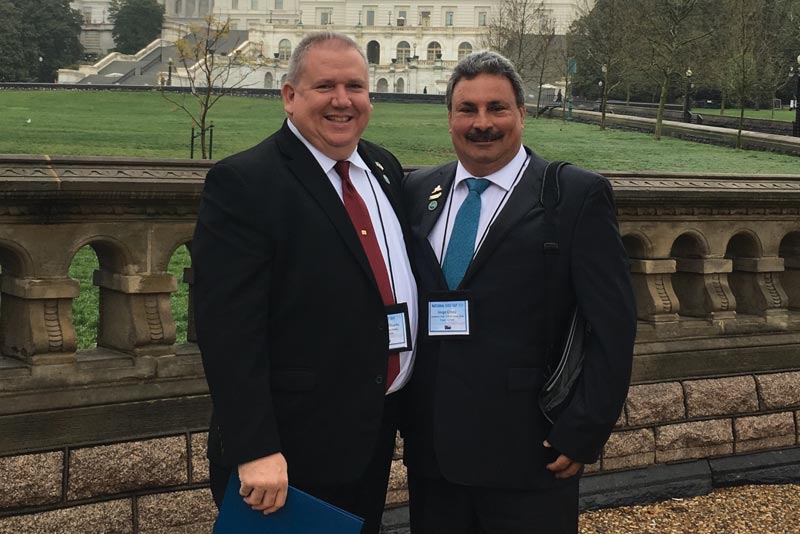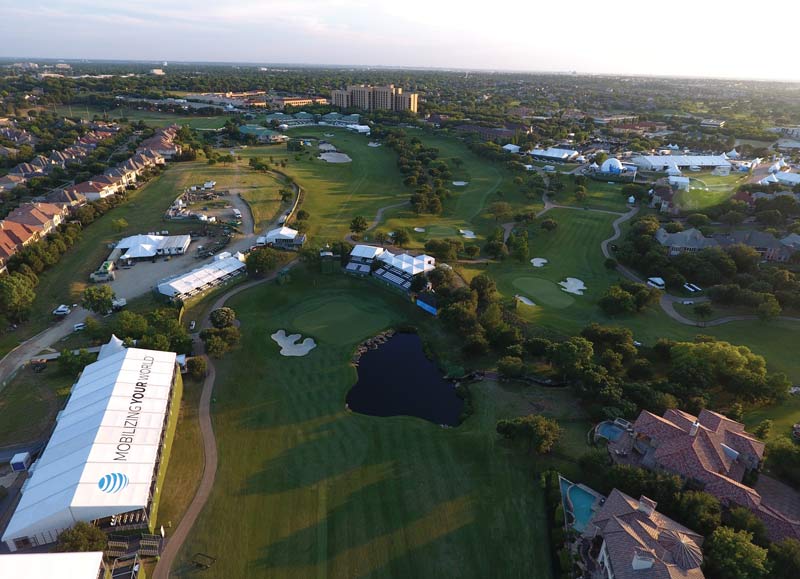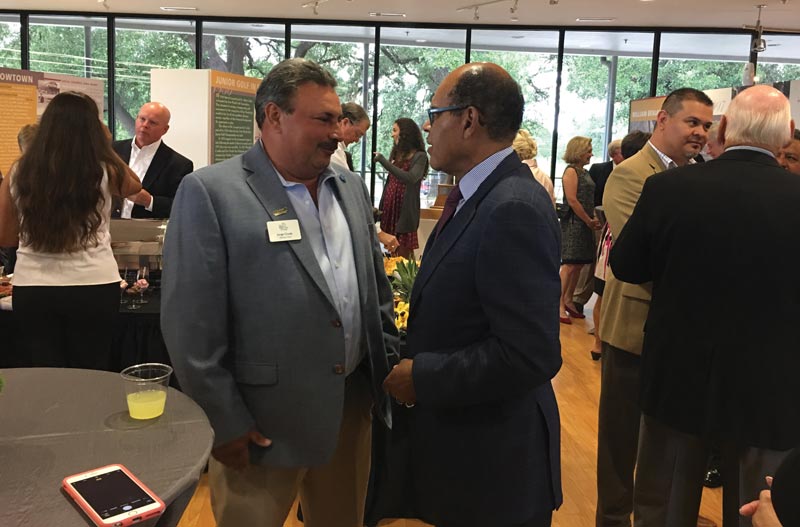
Co-authors Anthony L. Williams, CGCS, (left) and Jorge Croda, CGCS. Both participate in GCSAA’s Grassroots Ambassador program, engaging with policymakers to advocate on behalf of the golf industry. Photo courtesy of Anthony L. Williams
Golf course superintendents can be some of the most misunderstood professionals in the industry.
Rarely do you hear anything about a golf course superintendent or the maintenance staff’s daily accomplishments, but if something is wrong with the course, all eyes focus on the superintendent. The truth is that a superintendent’s job is mostly done behind the scenes, and the hallmark of a truly successful golf course superintendent is a course that runs seamlessly whether the superintendent is front and center or standing in the shadows.
The actual definition of a superintendent is a person who manages (or superintends) an organization or activity, or a high-ranking official. On average, nearly 80 percent of a golf course’s budget is managed by its superintendent. This alone moves the superintendent into a critical role for the success of the club. However, many people think of superintendents as just “lawn guys.”
As superintendents, we must learn to take responsibility for our perceived professionalism. We must commit to higher standards, starting with ourselves and extending through the industry in order to build respect and an understanding of our true worth.
Here are five simple ways to raise the bar and increase your professionalism as a golf course superintendent.
1. Cultivate craftsmanship
Craftsmanship is defined as the beautiful or impressive quality of something that has been made using a lot of skill.
Certainly, a highly maintained golf course is beautiful and practical and requires skill to sustain, but what about the superintendent whose vision and hands-on application bring this product of agronomic craftsmanship to life? This blend of work ethic and vision gives golf its soul and purpose (not to mention a place to exist). The superintendent must, through character and lifelong learning, exhibit the core strengths he aspires to instill in the course and his staff.
The superintendent must be a reflection of the course he or she manages and must mentor others to achieve this level of quality. Therefore, he must be a powerful blend of education and experience, seeking the highest quality of education tempered with grassroots, weathered-boots experience. The superintendent is a lifelong learner, collecting knowledge and wisdom from education that’s both formal (college classes, seminars, webinars, etc.) and informal (on-the-job training, conversations with peers, articles and books, etc.).

Nothing captures the overall craftsmanship and professionalism required from a superintendent and his team quite like an aerial shot at a televised PGA Tour event — in this case, the 2017 AT&T Byron Nelson Classic at TPC Four Seasons Golf and Sports Club Dallas at Los Colinas in Irving, Texas, where Anthony L. Williams, CGCS, is the director of golf course and landscape operations. Photo by Jacob Boelsche
The superintendent should demonstrate excellence in credentials and performance in various ways, such as certifications (CGCS and other GCSAA programs, Audubon International, e-par, GEO), licenses, case studies, articles, industry contests and presentations.
Strive to be the embodiment of the highest level of excellence personally and professionally so that, by every measure, your personal brand has value and your contributions to every aspect of our industry are evident and impactful. Make your presence so obvious that people who play your course and meet you are able to see and feel the powerful connection between your personal standards and the daily course standards.
This isn’t always easy, so remember that, for the professional superintendent, craftsmanship is a journey, not a destination. Grow a little every day (sort of like turfgrass).
2. Communication is key
We must forge communication in every place and in every way possible. The most crucial places to build communication are within our course, the golf industry and our extended communities (first our homes, then beyond). This means we should become experts in oral and written communication.
Be visible, contributing openly within your entire operation. Generate articulate reports and deliver inspiring presentations while making sure your core principles and philosophies are alive within your staff meetings. Constantly build relationships. Interact with guests, owners and other staff members. Attend or host events. All of these activities create deeper relationships and open opportunities to make the club better — to make you better.
Then, project your message into the golf industry. Attend events. Write articles. Enter contests. Volunteer to serve in industry associations or activities.
You will soon find that you get back more than you give.
Once you have raised your level of club and community professionalism, expand your outreach and impact into the world at large. Creative superintendents have contributed beyond golf in many ways, from helping with Habitat for Humanity to National Golf Day activities in Washington, D.C., to being featured on the front page of The New York Times. Take your skills and find a problem you can solve, and then tell that story.
Remember that emailing and texting are great ways to reach a large audience quickly, and they expand your professional presence exponentially. What about a blog? Technology is an amazing tool for broadening the scope of the information you share while validating your professionalism. How far you go is up to you, but if you commit to being a better communicator, you will certainly increase your worth and the professionalism of the entire industry.
3. Transparency is a must
In the classic film “The Wizard of Oz,” we hear the line, “Pay no attention to that man behind the curtain,” after the wizard had been found to be less than advertised.
One of the ways to increase professionalism as a superintendent is to commit to a high level of transparency within your operation and activities. You can accomplish this by pulling back the proverbial curtain on your operation. Invite all levels of stakeholders — from ownership, management, members and guests, club staff (other departments) and other industry professionals — to visit your shop and property. They will witness the many activities that you as a professional superintendent accomplish daily. If no one truly knows how much magic is happening within your operation, it is impossible for them to appreciate you or your staff appropriately.
On the flip side of that, be open to spending a day with them to gain insight into how others manage their departments or properties, or how they interact with and use the golf course assets. A successful superintendent is always learning from every situation — never pass up an opportunity to look beyond your own operation or have your skills validated to gain insights and perspective. Transparency is an important part of professionalism.
4. The power of professional protocol
What exactly is “protocol”? Protocol is a system of rules that explains the correct conduct and procedures to be followed in formal or informal situations. For our purposes, we will focus on both written and unwritten rules that serve as a standard of excellence for the professional golf course superintendent.
If you want to raise the bar on your professionalism, start with the written protocols for your property. These include things like dress codes, punctuality expectations, codes of conduct, rules of ethics and standard operating procedures. You should be the exacting example of these protocols. Look and act the part of a property and/or industry expert.

Creative partnerships and the use of advanced technology help superintendents raise the bar on key management practices. Here, a dredge hangs over a fairway to begin a silt removal operation, the result of a partnership between a golf course and a local utility corporation. Photo by Anthony L. Williams
Once you’ve mastered the written rules, you can progress to the unwritten protocols. These hidden gems are harder to master but can often be the difference between good and great professionalism.
Hospitality is an example of an unwritten protocol. When interacting with a guest or golfer, make eye contact at 10 feet, acknowledge and smile at 2 feet, and use the person’s name, if possible. Always wave or in some way acknowledge others when driving past them on the course.
Random acts of kindness are also part of this category. For example, there was a superintendent who literally gave the shoes off his feet to help a guest of a member. The member had invited his brother-in-law to play golf. They ran into the superintendent on the way to the driving range and discovered the guest had forgotten his golf shoes. The superintendent asked the guest’s shoe size and was told size 12. The superintendent also wore size 12, and he had just picked up a new pair of golf shoes (still in the box). He offered the shoes to the guest, who wore them, had a great round and sent a letter to the general manager praising the superintendent. He eventually bought the shoes. Such acts certainly are professional and definitely impactful, but they’re never really listed in the employee handbook.
The best example of a golf course superintendent’s professional protocol is the GCSAA Code of Ethics. The GCSAA bylaws actually give power to the Board of Directors to enforce the Code of Ethics in Article III, Sections 2-3, available on the GCSAA website. Look it up.
5. Innovation: Thinking outside the box
Consider unconventional ways to demonstrate the responsibilities and expertise that constitute the professionalism of the superintendent.
It could be something simple. You could give a short presentation at a staff meeting about new trends in course maintenance or something noteworthy that has taken place. Did you or your property win an industry award? Contribute to the club newsletter, but go beyond weather and course-condition updates. What about planning a department cookout and inviting management, employees, members, local politicians and other special guests to come and socialize?
Also, think about using your course as an outdoor classroom for case studies or hosting field trips for local science classes. How about partnering with your local visitors bureau to highlight what your course offers to the area? Can you use technology to expand your communication and outreach to include social media? Perhaps you can invest in a drone to capture aerial views of your course and activities.
The key is to find an idea and take action. Even a small project could have big impact. For instance, are you using your smartphone to its full potential? With the latest apps and a high-resolution camera always at the ready, you just might find an innovative use for this tool, moving you to the head of the class as a forward-thinking professional superintendent.

Co-author Jorge Croda, CGCS, (left) with recently retired First Tee CEO Joe Louis Barrow Jr. Organizations such as The First Tee provide an outlet for superintendents to exhibit their commitment to professionalism. Photo courtesy of Jorge Croda
Thinking outside the box many not always be easy, but the things worth doing rarely are. If we all take a grassroots approach to increasing the knowledge and exposure of our field, we can create a vast web of people who understand the importance of the superintendent position. It is a win-win for everybody.
This is the path to professionalizing the position and image of the superintendent, and it just might change the look and impact of how we manage the game. The future could be filled with alternative-fuel mowers, safer and more effective pesticides, improved varieties of turf, more profits and less inputs, all because of the efforts of a few professional golf course superintendents with innovative ideas and vision.
Professionalism: Putting it all together
Every superintendent has a unique blend of education and experience that allows him or her to view the course from a multitude of perspectives. However, how the superintendent is viewed by others is a matter of professional and personal perception.
By using craftsmanship, communication, transparency, protocol and innovation, the superintendent can create a powerful professional image — one that transcends stereotypes and sets the cornerstone for success in the golf course management industry.
It takes perseverance to overcome years of misunderstanding. Are you ready to raise the bar within your personal professionalism as a golf course superintendent? We hope this article will spark a revival of professionalism that will help others understand just how valuable the golf course superintendent is and that we support each other by building up the positive and displacing the negative.
When it comes to professionalism, our words and actions paint the pictures that shape our industry, so learn, do, teach and repeat.
Jorge Croda, CGCS, is a 12-year GCSAA member and has more than 20 years of experience in industrial engineering, consulting and golf course industries. Anthony L. Williams, CGCS, is a 22-year GCSAA member and is the director of golf course and landscape operations at TPC Four Seasons Golf and Sports Club Dallas at Los Colinas.